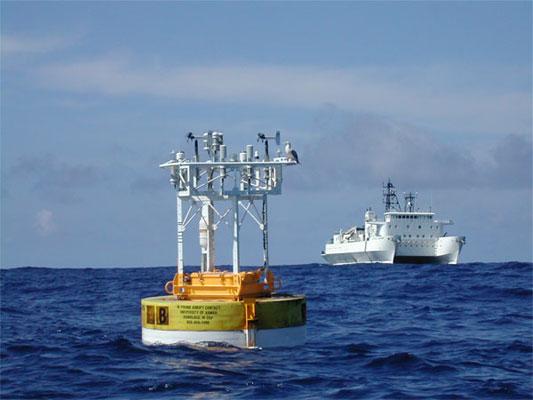New gene catalog of ocean microbiome reveals surprises

WHOTS buoy marks the edge of Station ALOHA 100 km north of O'ahu, with the UHM vessel, R/V Kilo Moana. Credit: Paul Lethaby, UHM SOEST
As a group, marine microbes are extremely diverse and versatile with respect to their metabolic capabilities. All of this variability is encoded in their genes. Some marine microorganisms have genetic instructions that allow them to use the energy derived from sunlight to turn carbon dioxide into organic matter. Others use organic matter as a carbon and energy source and produce carbon dioxide as a respiration end-product. Other, more exotic pathways have also been discovered.
“But how do we characterize all these diverse traits and functions in virtually invisible organisms, whose numbers approach a million cells per teaspoon of seawater?” asked DeLong, senior author on the paper. “This newly constructed, comprehensive gene catalog of microbes inhabiting the ocean waters north of the Hawaiian Islands addresses this challenge.”
Water samples were collected over two years, and modern genome sequencing technologies were used to decode the genes and genomes of the most abundant microbial species in the upper 3,000 feet of water at the Hawai'i Ocean Time-series (HOT) Program open ocean field site, Station ALOHA.
Just below the depth of sunlit layer, the team observed a sharp transition in the microbial communities present. They reported that the fundamental building blocks of microbes, their genomes and proteins, changed drastically between depths of about 250-650 feet.
“In surface waters, microbial genomes are much smaller, and their proteins contain less nitrogen–a logical adaptation in this nitrogen-starved environment,” said Daniel Mende, post-doctoral researcher at the UHM School of Ocean and Earth Science and Technology (SOEST) and lead author on the paper. “In deeper waters, between 400-650 feet, microbial genomes become much larger, and their proteins contain more nitrogen, in tandem with increasing nitrogen availability with depth.”
“These results suggest that the availability of nutrients in the environment may actually shape how microbial genomes and proteins evolve in the wild,” said DeLong. “Another surprising finding of the study is that the microbial 'genomic transition zone' observed occurs over a very narrow depth range, just beneath the sunlit layer. Below about 650 feet deep, the fundamental properties of microbial genomes and proteins are relatively constant, all the way down to the seafloor.”
In collaboration with a computer science group led by professor Bonnie Hurwitz at the University of Arizona, the new database is available to scientists worldwide who are seeking to describe the nature and function of microbes in the global oceans.
“These new data will provide an important tool for understanding the nature and function of the ocean's microbiome today, as well as help predict its trajectory into the future,” said DeLong.
Media Contact
All latest news from the category: Life Sciences and Chemistry
Articles and reports from the Life Sciences and chemistry area deal with applied and basic research into modern biology, chemistry and human medicine.
Valuable information can be found on a range of life sciences fields including bacteriology, biochemistry, bionics, bioinformatics, biophysics, biotechnology, genetics, geobotany, human biology, marine biology, microbiology, molecular biology, cellular biology, zoology, bioinorganic chemistry, microchemistry and environmental chemistry.
Newest articles

NASA: Mystery of life’s handedness deepens
The mystery of why life uses molecules with specific orientations has deepened with a NASA-funded discovery that RNA — a key molecule thought to have potentially held the instructions for…

What are the effects of historic lithium mining on water quality?
Study reveals low levels of common contaminants but high levels of other elements in waters associated with an abandoned lithium mine. Lithium ore and mining waste from a historic lithium…

Quantum-inspired design boosts efficiency of heat-to-electricity conversion
Rice engineers take unconventional route to improving thermophotovoltaic systems. Researchers at Rice University have found a new way to improve a key element of thermophotovoltaic (TPV) systems, which convert heat…



